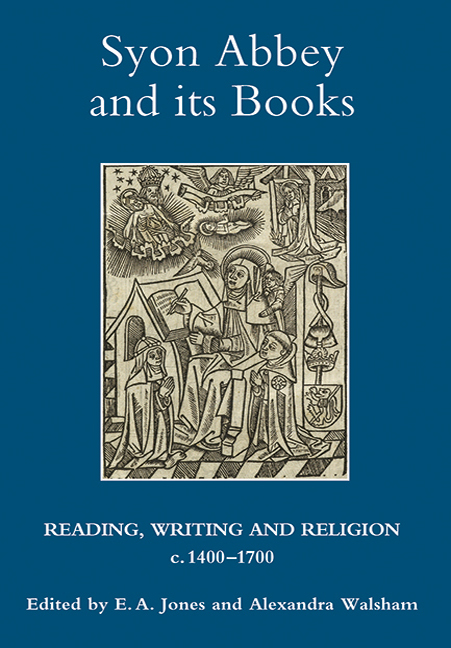Book contents
- Frontmatter
- Contents
- List of Illustrations
- Acknowledgments
- Notes on Contributors
- List of Abbreviations
- Syon Abbey: An Outline Chronology
- Introduction: Syon Abbey and its Books: Origins, Influences and Transitions
- I Brothers and Sisters
- 1 The Brothers of Syon, 1420–1695
- 2 Syon Abbey: Women and Learning c.1415–1600
- II Syon Abbey and the Book Trade
- III The Bridgettines in Exile
- IV History and Memory
- Appendix Syon Abbey's Books at the University of Exeter
- Index
- Miscellaneous Endmatter
1 - The Brothers of Syon, 1420–1695
from I - Brothers and Sisters
Published online by Cambridge University Press: 09 May 2017
- Frontmatter
- Contents
- List of Illustrations
- Acknowledgments
- Notes on Contributors
- List of Abbreviations
- Syon Abbey: An Outline Chronology
- Introduction: Syon Abbey and its Books: Origins, Influences and Transitions
- I Brothers and Sisters
- 1 The Brothers of Syon, 1420–1695
- 2 Syon Abbey: Women and Learning c.1415–1600
- II Syon Abbey and the Book Trade
- III The Bridgettines in Exile
- IV History and Memory
- Appendix Syon Abbey's Books at the University of Exeter
- Index
- Miscellaneous Endmatter
Summary
Past scholarship on Syon Abbey has focused almost entirely on the nuns who formed the larger part of the English Bridgettine community. The nuns, who were more usually referred to as ‘sisters’ in England, were certainly numerically superior and constitutionally more central to the life of Syon than their male counterparts, but the brothers were nevertheless an indispensable element within the distinctive Bridgettine regular life. The primary role of the brothers was to provide spiritual services to the strictly enclosed female community, but they also had their own choral duties to perform and spent a great deal of their time in study. For this reason Syon attracted men of learning from Oxford, Cambridge and London, and they brought with them their personal collections of books which in time formed one of the largest monastic libraries in late medieval England. This role in amassing such a splendid collection of books would be reason enough to justify a closer examination of the brothers of Syon. Throughout its existence, however, the monastery also drew into its cloisters men of considerable piety and even sanctity, and two of these brothers were to die for their faith during the Henrician reformation. In the words of Dom David Knowles, this was a group of male religious
… without parallel in Tudor England; men who combined personal austerity of life with theological or devotional competence, and who by their books, by their direction of a fervent and aristocratic nunnery, and by their influence as counsellors and confessors of leading laymen, were a power to be reckoned with in a religious world which contained all too few centres of enlightened piety.
Indeed, Knowles placed the Bridgettines of Syon among the spiritually elite company of the Observant Franciscans and the Carthusians, the only other sections of the regular clergy which he felt were deserving of lamentation after the suppression of the monasteries in the 1530s.
Historians of Syon Abbey are in the fortunate situation of having at their disposal a range of surviving constitutional and customary documents which allows them to reconstruct the distinctive form of religious life led by the English Bridgettines.
- Type
- Chapter
- Information
- Syon Abbey and its BooksReading, Writing and Religion, c.1400-1700, pp. 39 - 81Publisher: Boydell & BrewerPrint publication year: 2010

